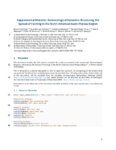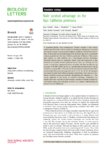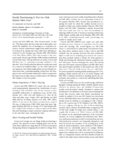|
|
Creator | Title | Description | Subject | Date |
| 1 |
 |
Rogers, Alan R. | Pleistocene population X-plosion? | In two recent papers, Kaessmann et al. presented DNA sequence data from the X chromosome (Xq13.3) of 30 chimpanzees and 69 humans (Kaessmann et al. 1999a; Kaessmann et al. 1999b). These data bear on two longstanding questions involving late Pleistocene demographic history: (1) whether the long-term... | | 2000 |
| 2 |
 |
Rogers, Alan R. | Genetic evidence for a Pleistocene population explosion | Expansions of population size leave characteristic signatures in mitochondrial "mismatch distributions." Consequently, these distributions can inform us about the history of changes in population size. Here, I study a simple model of population history that assumes that, t generations before the pr... | | 1995 |
| 3 |
 |
Bell, Adrian | Driving factors in the colonization of Oceania: developing island-level statistical models to test competing hypotheses (Electronic Supporting Material) | To test the model specification and fitting algorithms, we simulated data using randomly generated parameters, settlement chronology, and accessibility matrix for N islands. Using the function optim in R, we found the maximum likelihood estimates and compared them with the "true" parameter values us... | Oceania; Archaeology; Settlement; Statistical models | 2015-01-23 |
| 4 |
 |
Rogers, Alan R. | Is migration kin structured? | We estimate the strength of kin-structured migration in six human populations (five from New Guinea and one from Finland) and in one population of nonhuman primates. We also test the hypothesis that migration is not kin structured by generating a sampling distribution of the estimator under the null... | | 1994 |
| 5 |
 |
O'Rourke, Dennis H. | Patterns of genetic variation in native America | Allele frequencies from seven polymorphic red cell antigen loci (ABO, Rh, MN, S, P, Duffy, and Diego) were examined in 144 Native American populations. Mean genetic distances (Nei's D) and the fixation index FST are approximately equal for the North and South American samples but are reduced in the... | Gene frequencies; Amerinds; Genetic Distance | 1992 |
| 6 |
 |
Rogers, Alan R. | How much can fossils tell us about regional continuity? | Presents a study on the genetic contribution of earlier populations to later populations within regions called regional continuity. Testing for regional continuity with multiple characters; Replacement of archaic population by a population of modern humans. | Human genetics; Fossils; Regional continuity | 2006-06-05 |
| 7 |
 |
Rogers, Alan R.; Harpending, Henry C. | Mismatch distributions of mtDNA reveal recent human population expansions | Although many genetic studies of human evolution have tried to make distinctions between the replacement and the multiregional evolution hypotheses, current methods and data have not resolved the issue. However, new advances in nucleotide divergence theory can complement these investigations with a ... | | 1994 |
| 8 |
 |
Rogers, Alan R.; Jorde, Lynn B. | Genetic structure of the Utah Mormons: comparison of results based on RFLPs, blood groups, migration matrices, isonymy, and pedigrees | The genetic structure of the Utah Mormon population is examined using 25 blood group and 47 RFLP alleles obtained from 442 subjects living in 8 geographic subdivisions. Nei's Gst was 0.013 (p < 0.002) for the RFLP data and 0.012 (p > 0.4) for the blood group data, showing that only 1% of the geneti... | | 1994 |
| 9 |
 |
O'Rourke, Dennis H. | Unangan past and present: the contrasts between observed and inferred histories | Abstract Academic research focusing on the population and culture history of the Aleut (Unangan) people began in the late 19th century and continues to the present. The papers in this special issue of Human Biology summarize the latest results from archaeological, linguistic, genetic, and morphometr... | | 2010 |
| 10 |
 |
Cashdan, Elizabeth A. | On territoriality in hunter-gatherers | Cashdan's intention of using an evolutionary framework to examine cross-cultural variations in territorial defense is admirable, but her argument about the applicability of available models, her own model, and the data used to support it (CA 24:47-66) are all severely flawed. Specifically, Cashdan ... | Defense; Organisms; Behavior | 1983 |
| 11 |
 |
Hawkes, Kristen | Food sharing among Ache hunter-gatherers of Eastern Paraguay | Empirical research on food sharing among hunter-gatherers should provide critical data for evaluating both the possible role of food sharing in hominid evolution and the question of how such behavior could be selected. | Hunter-gatherers; Ache; Paraguay; Anthropology | 1988-02 |
| 12 |
 |
Rogers, Alan R. | Quantitative genetics of sexual dimorphism in human body size | A classical data set is used to predict the effect of selection on sexual dimorphism and on the population means of three characters--stature, span, and cubit--in humans. Given selection of equal intensity, the population means of stature and of cubit should respond more than 60 times as fast as d... | Societies; Selection; Species | 1992 |
| 13 |
 |
Wiessner, Pauline W. | On network analysis: the potential for understanding (and misunderstanding) !Kung Hxaro | Schweizer's social network analysis (CA 38: 739-52) of gift giving among the !Kung San (Ju/'hoansi) demonstrates most elegantly how individual strategies, guided by basic cultural rules, coalesce to form a regional system. Complex connections in the network that defied description with simpler anayt... | Density of kinship; Nonsymmetry; Ethnohistorica | 1998-08 |
| 14 |
 |
Codding, Brian F. | Supplementary Materials: Socioecological dynamics structuring the spread of farming in the North American Basin-Plateau Region | This document includes the code used to complete the analysis presented in the manuscript "Socioecological Dynamics Structuring the Spread of Farming in the North American Basin-Plateau Region" in Environmental 15 Archaeology. | environmental archaeology | |
| 15 |
 |
Macfarlan, Shane | Male Survival Advantage on the Baja California Peninsula | A consistent finding from contemporary Western societies is that women outlive men. However, what is unclear is whether sex differences in survival are constant across varying socio-ecological conditions. We test the universality of the female survival advantage with mortality data from a nineteenth... | ecology; health and disease and epidemiology; behaviour | 2020 |
| 16 |
 |
O'Rourke, Dennis H. | Refutation of the general single locus model for the etiology of schizophrenia | All published studies on the familial incidence of schizophrenia appropriate for testing the applicability of the general single-locus two-allele model are examined under the assumption of a unitary etiology for all schizophrenia. We show that the single major locus model is inadequate to predict th... | Genetics; Diseases in Twins; Chromosome Mapping | 1982 |
| 17 |
 |
Hawkes, Kristen | The derived features of human life history | This chapter compares and contrasts the life histories of extant great apes in order to construct a hypothetical life history of the last common ancestor of all great apes and to identify features of human life history that have been derived during the evolution of our lineage. Data compiled from th... | | 2006-01-01 |
| 18 |
 |
Hawkes, Kristen | Family provisioning is not the only reason men hunt | Gurven and Hill (2009) ask, "Why do mean hunt?" As they say, "The observation that mean hunt and women gather supported the simplistic view of marriage as a cooperative enterprise. Greater sophistication suggests that males may often be motivated by mating and status rather than offspring investment... | | 2010-01-01 |
| 19 |
 |
Rogers, Alan R. | Migration and genetic drift in human populations | In humans and many other species, mortality is concentrated early in the life cycle, and is low during the ages of dispersal and reproduction. Yet precisely the opposite is assumed by classical population-genetics models of migration and genetic drift. We introduce a model in which population regul... | Frequencies; Variance; Dynamics | 1986 |
| 20 |
 |
Rogers, Alan R.; Jorde, Lynn B. | Modeling the amplification dynamics of human Alu retrotransposons | Retrotransposons have had a considerable impact on the overall architecture of the human genome. Currently, there are three lineages of retrotransposons (Alu, L1, and SVA) that are believed to be actively replicating in humans. While estimates of their copy number, sequence diversity, and levels of ... | Retrotransposons; Amplification dynamics; Mutation; Human-chimpanzee divergence | 2005 |
| 21 |
 |
Codding, Brian F. | External impacts on internal dynamics: Effects of paleoclimatic and demographic variability on acorn exploitation along the Central California coast | Research into human-environment interaction in California prehistory often focuses on either the internal dynamics of adaptive decisions or the external impacts of environmental change. While both processes were surely driving prehistoric variability, integrating these approaches is not altogether s... | Acorn exploitation; Prehistoric land use; Behavioral ecology | 2016 |
| 22 |
 |
Cashdan, Elizabeth A. | How women compete | Men are more physically aggressive and more risk-prone than women, but are not necessarily more competitive. New data show the gender difference in competitiveness to be one of kind rather than degree, with women and men competing in different ways and, to some extent, over different objectives, but... | Gender differences, behavior; Competition; Aggression | 1999-06 |
| 23 |
 |
Harpending, Henry C.; Jorde, Lynn B. | Culture creates genetic structure in the Caucasus: autosomal, mitochondrial, and Y-chromosomal variation in Daghestan | Near the junction of three major continents, the Caucasus region has been an important thoroughfare for human migration. While the Caucasus Mountains have diverted human traffic to the few lowland regions that provide a gateway from north to south between the Caspian and Black Seas, highland populat... | Caucasus; Haplogroups; Autosomal variation; Mitochondrial variation; Y-chromosomal variation; Endogamy; Avar; Dargin; Kubachi; Culture | 2008 |
| 24 |
 |
Rogers, Alan R.; Harpending, Henry C. | Genetic structure of ancient human populations | Discusses mitochondrial DNA (mtDNA) sequences as important source of data about the history of human species. | Tree of descent; Mismatch distributions; Simulations; Findings; Intermatch distributions; Younger and older populations | 2001-09-15 |
| 25 |
 |
Rogers, Alan R.; Jorde, Lynn B. | Genetic evidence on modern human origins | A review of genetic evidence leads to the following conclusions concerning human population history: (1) Between 33,000 and 150,000 years ago the human population expanded from an initial size of perhaps 10,000 breeding individuals, reaching a size of at least 300,000. (2) Although the initial popu... | Population history; Mitochondrial DNA; Mismatch distribution; Intermatch distribution; Replacement hypothesis; Population bottlenecks | 1995 |

























